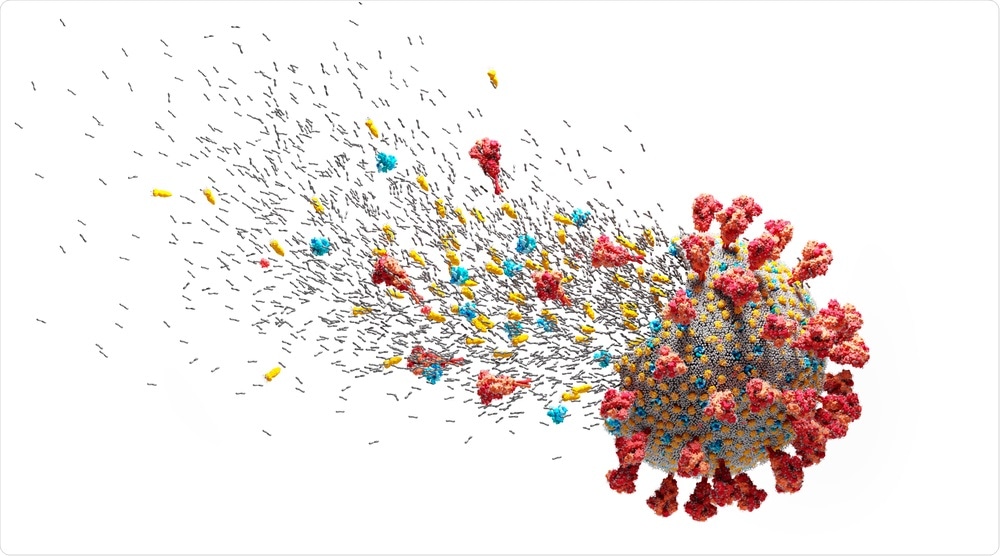As of July 13, 2021, the coronavirus disease 2019 (COVID-19), which is caused by the severe acute respiratory syndrome coronavirus 2 (SARS-CoV-2), has infected over 187 million people and caused the deaths of over 4 million people worldwide. Upon infection by SARS-CoV-2, this virus binds with high affinity to the human angiotensin converting enzyme-2 (ACE2) receptor present on the surface of human cells. This mechanism has therefore been of interest to many researchers looking to develop treatments that could block ACE2 and/or disable the spike (S) protein of SARS-CoV-2.
A new study reports the results of molecular dynamic simulations that were performed in an effort to identify new drugs that could be effective against SARS-CoV-2.
 Study: The molecular dynamics of possible inhibitors for SARS-CoV-2. Image Credit: PHOTOCREO Michal Bednarek / Shutterstock.com
Study: The molecular dynamics of possible inhibitors for SARS-CoV-2. Image Credit: PHOTOCREO Michal Bednarek / Shutterstock.com
Background
The S protein of SARS-CoV-2 is made up of S1 and S2 subunits that mediate ACE2 engagement and viral-cell membrane fusion to ultimately allow for viral entry into the host cell. The S1 subunit carries the receptor-binding domain (RBD) that bears the receptor-binding motif (RBM), which is the location of residues that bind to the ACE2 interface.
Despite intensive efforts that have been made by the global scientific community to develop antiviral agents against SARS-CoV-2, their success has been limited. As a result, most physicians have instead relied on well-known drugs that are capable of reducing inflammation in patients with severe or critical COVID-19 in order to prevent multi-organ damage and death.
Many screening studies have been carried out to identify new drugs and/or repurpose those that are readily available. To this end, in silico techniques have been of great use in the initial identification of such compounds.
What did the study show?
In the current report, which was published in the Journal of Biomolecular Structure and Dynamics, the authors described the use of molecular dynamics simulations to explore the binding affinities of nine compounds. Of these nine compounds, three were found to show significant therapeutic potential, which included SN35563, arbidol, and hydroxychloroquine.
SN35563, which is also known as R5, is a ketamine ester analog that wears off rapidly but continues to antagonize pain stimuli for a prolonged period. In the current study, the researchers found that while SN35563 binds at high affinity to the ACE2 receptor, it was not capable of binding to the SARS-CoV-2 S or RBD proteins at comparable levels.
Arbidol is a non-nucleoside broad-spectrum antiviral compound that is thought to inhibit virus-host cell membrane fusion while simultaneously strengthening immunity. At molecular levels, arbidol was found to preferentially bind to aromatic residues. When used clinically, arbidol has improved various health parameters in COVID-19 patients including oxygen saturation levels, as well as reduced intensive care unit (ICU) admissions and duration of hospitalization, with earlier discharge.
Hydroxychloroquine is both an anti-malarial and immunomodulatory drug that is widely used in the treatment of autoimmune arthritides as a disease-modifying anti-rheumatic drug (DMARD). Both abridol and hydroxychloroquine were found to block the viral S protein without attaching to the ACE2 receptor. Based on the molecular dynamics simulations, the researchers believe that optimal blockade of SARS-CoV-2 invasion could successfully be achieved by a combination of arbidol or hydroxychloroquine with SN35563, as SN35563 can block the ACE2 receptor to compensate for the inability of the former agents to do so.
Remdesivir, which is an antiviral that has been extensively used to treat COVID-19 patients, was also studied in the current study. To this end, the researchers found that this agent may actually increase the risk of host cell infection as a result of its equal binding affinity to both the S and RBD proteins, as well as the ACE2 receptor. By binding to both simultaneously, remdesivir reduces the distance between the viral proteins and host cell receptor, thereby making viral infection more probable.
What are the implications?
Further tests will be required to determine whether combinations of SN35563 with either arbidol or hydroxychloroquine may have a synergistic effect on cell entry. If so, this combination treatment be extremely useful in blocking the ACE2 receptor and reducing the binding of SARS-CoV-2 to this receptor on the host cells. Moreover, the dose of each drug could be reduced in such combination treatment approaches.
Through the use of molecular dynamics simulations, the current study demonstrated a possible mechanism of action of three candidate compounds, which could lead to the development of potent antiviral drugs in the near future.